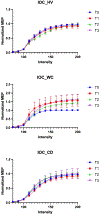Differential induction of Parieto-motor plasticity in writer's cramp and cervical dystonia
- PMID: 39491631
- PMCID: PMC11578765
- DOI: 10.1016/j.nbd.2024.106724
Differential induction of Parieto-motor plasticity in writer's cramp and cervical dystonia
Abstract
Objectives: To investigate the plastic effects of parieto-motor (PAR-MOT) cortico-cortical paired associative paired stimulation (cc-PAS) in patients with two forms of focal dystonia, writer's cramp and cervical dystonia, compared to healthy volunteers (HVs).
Methods: We used cc-PAS to induce associative plasticity using repeated time-locked paired transcranial magnetic stimulation (TMS) pulses over the parietal and motor cortices in 16 patients with writer's cramp (WC), 13 patients with cervical dystonia (CD), and 23 healthy volunteers. We measured parieto-motor corticocortical connectivity using posterior parietal cortex (PPC) to primary motor cortex (M1) facilitation and input-output curves (IOC) of the motor-evoked potential (MEP) before and after PAR-MOT cc-PAS. The PAR-MOT cc-PAS consisted of 100 pairs of TMS pulses every 5 s, with the conditioning pulse applied to the left angular gyrus in the intraparietal sulcus and the test pulse applied to the M1 hotspot of the first dorsal interosseous muscle.
Results: The cc-PAS increased the area under the IOC by increasing its maximum level in patients with WC but not in patients with CD or healthy volunteers. The cc-PAS had no significant effect on other IOC parameters. There were no significant differences in PPC to M1 facilitation changes after PAR-MOT cc-PAS among all groups.
Conclusions: This study suggests that PAR-MOT cc-PAS abnormally increases M1 excitability in patients with WC but not in those with CD. Additionally, this increased plastic response in patients with WC does not appear to be directly linked to PPC to M1 corticocortical connectivity.
Keywords: Cervical dystonia; Parieto-motor associative plasticity; Parieto-motor connectivity; writer's cramp.
Copyright © 2024. Published by Elsevier Inc.
Conflict of interest statement
Declaration of competing interest All authors report no conflicts of interest.
Figures




References
-
- Arai N, et al., 2012. Effective connectivity between human supplementary motor area and primary motor cortex: a paired-coil TMS study. Exp. Brain Res 220, 79–87. - PubMed
Publication types
MeSH terms
Grants and funding
LinkOut - more resources
Full Text Sources

